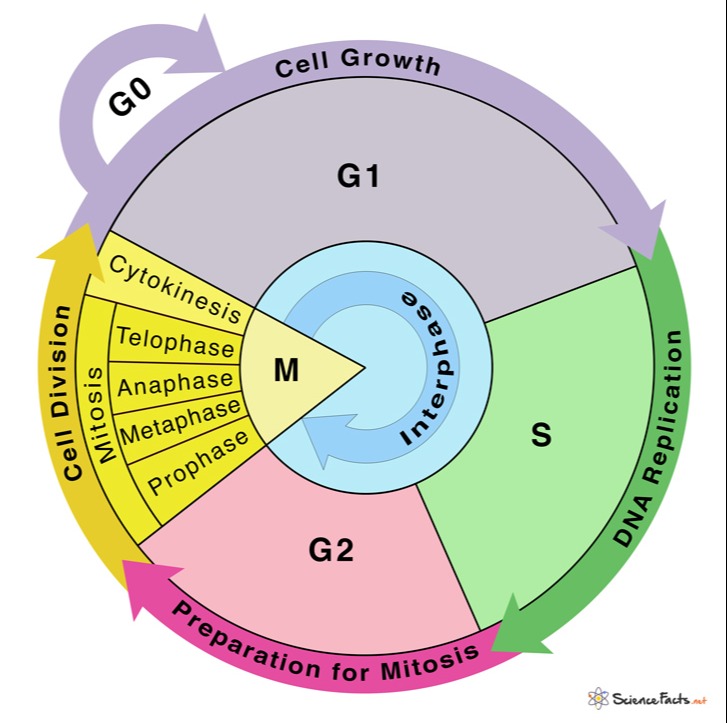The Cell Cycle Study Guide
Key Points
- The cell spends most of its life in interphase preparing for mitosis.
- Mitosis is the process of splitting a cell into two daughter cells.
- Cytokinesis is after mitosis when the cell actually splits.
The Life of a Cell
A cell spends most of its life growing and replicating its DNA. This phase called the interphase, consists of a G1 phase, S phase, and G2 phase.
- 👶 G1 phase – Cell is growing, which means it is accumulating nucleotides to make DNA and proteins, as well as energy reserves.
- 🧬 S Phase – DNA is replicated, however it still stays in a semi-condensed form. Organization will happen during mitosis.
- 🍖 G2 Phase – The cell essentially just stores up some more food and resources.

Mitosis and Cytokinesis
Although interphase is where cells spend most of their life, mitosis is where all the action happens.
During prophase, chromosomes condense and become defined. Spindle fibers emerge from centrosomes, and the nuclear envelope disappears.
Metaphase is the second state where the chromosomes start lining up and the spindles attach to each sister chromatid. The centrosomes then make their journey to opposite sides of the cell.
After determining the chromosomes are all lined up the cell will kick off anaphase where the sister chromatids separate for good 😭 , pulled apart from the mitotic spindle (which is attached to the centresome).
The cell finishes mitosis with telophase where the chromosomes start decondensing at opposite poles of the cell. The cell also gets rid of the mitosis machinery such as the mitotic spindle, while bringing back the nuclear envelop around each set of chromosomes.

Although mitosis has finished, you are still left with two sets of DNA in a single cell. Cytokinesis is where they split apart into two cells. Although mitosis is the same in plant and animal cells, cytokinesis is not.
-
🐨 In animal cells, a contractile ring forms, which pulls the cell creating a fissure called the cleavage furrow. The ring keeps contracting until the cell membrane is cleaved into two.
-
If you think back to the parts of a plant cell, remember that they have a cell wall. So during cytokinesis in a plant cell, enzymes, proteins, and glucose molecules come together to form a cell plate. That cell plate is then turned into a new cell wall.

Conclusion:
The cell cycle is an important life event during cell division. It is the multi-phased process of synthesis, supplication, and transferring. The 4 major steps important for the cell cycle are:
- Gap 1 (G1)
- Synthesis (S)
- Gap 2 (G2)
- Mitosis (M)
FAQs:
1. Which cells go through mitosis?
In animals, all cells (with the exception of reproductive cells) undergo mitosis. ☘️ With plants, mitosis only happens in certain growing regions, called apical meristems (often found in the stems and roots).
2. How many chromosomes are present during each stage of the cell cycle?
(For this example we will be talking about a human cell, however the ratios remain consistent with other species).
- The cell starts off with 46 chromosomes in 2 sets of 23 pairs.
- Then it doubles, however technically it still has 46 chromosomes because each chromosome is now made up of two sister chromatids.
- Then during mitosis after the sister chromatids are pulled apart, each side of the cell has 46 ‘regular’ chromosomes.
3. What are the 4 stages of the cell cycle?
The cell cycle is a 4-stage process. Step 1 is Gap 1 (G1), step 2 is synthesis (S), step 3 is Gap 2 (G2), and step 4 is mitosis (M).
4. What is the 6 cell cycle in order?
The 6 steps are- prophase, prometaphase, metaphase, anaphase, telophase, and cytokinesis.
5. How are G1 and G2 different?
In the G1 phase of the cell cycle, the cell grows larger, making organelles and other building blocks. G2 is the phase that precedes mitosis, and there is the synthesis of extra protein.
6. Which phase comes between G1 and G2?
The S phase, aka the synthesis phase.
7. What happens in anaphase?
During anaphase, each pair of chromosomes is divided between two identical cells.
We hope you enjoyed studying this lesson and learned something cool about the Cell Cycle! Join our Discord community to get any questions you may have answered and to engage with other students just like you! Don’t forget to download our App and check out our awesome VR room for this guide – we promise, it makes studying much more fun 😎
]]>